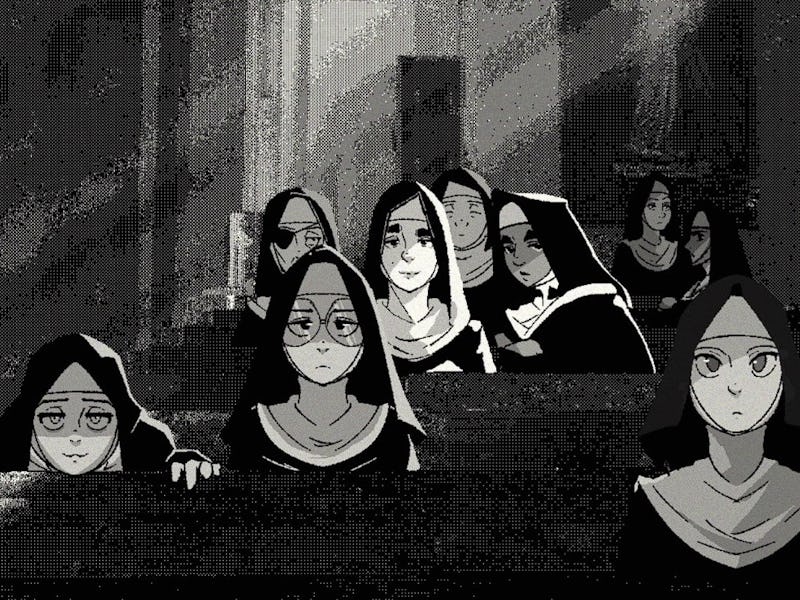Sister Hedwig is dead ... to the world. As an anchoress residing within a 15th-century abbey, her role is to live her life within a single cell without interaction with the outside world and devote herself to studying scripture. Sister Catherine is dead ... dead dead. As the only resident of the abbey with a foolproof alibi, Sister Hedwig is born into the world again to solve the murder. Thus begins Misericorde: Volume One, a visual novel that surrounds the aftermath of Catherine’s demise through conversations between Hedwig and the other residents of the abbey in the form of stunning prose that immerses the player like a good novel.
Unbeknownst to the Mother Superior and the other nuns of the abbey, Hedwig and Catherine had a short-lived but intense friendship. The cell that Hedwig resides in has a small hole through which others can ask questions about scripture, as she is a living encyclopedia. Catherine was a constant visitor.
The vignette of the two’s budding relationship that makes up the early moments of Misericorde is a taste of things to come. The dialogue is sharp and full of a million unsaid things and emotions. You can feel Hedwig get giddy at the prospect of having a friend, and the freedom that Catherine feels now that she has someone, she can tell the thoughts she typically would keep to herself. Game’s writing can often feel disjointed and bereft of feeling but Misericorde gave me whiplash by having me laughing hysterically one moment and sobbing openly the next.
Catherine asks at one point if Hedwig can see the sun. Hedwig responds that of course; She has a window. But it faces neither east nor west. Hedwig cannot remember seeing the sun, as she has been locked away for 20 years. She is a living example of Plato’s allegory of the cave, something Hedwig would know nothing about since she only has scripture and texts on theology. But it's a moment that cuts so deeply into who Hedwig is and her concept of the world, while also having the literary flourishes of the texts that seem to inspire Misericorde.
If you thought Pentiment was a game for English majors, then wait until Misericorde bombards you with so many references to history and literature that would occupy the minds of 15th-century nuns.
Once finally outside of her cell, Mother Superior tasks Hedwig with uncovering who murdered Catherine. Under the guise of becoming the new abbey chronicler, Hedwig then must go about introducing herself and getting to know the other sisters who range in age and ethnicity but all share the vocation, though their reasons differ as well. The personality of each sister is communicated so effectively by the distinct tones of how they all talk, as well as the simple but evocative black-and-white art that accompanies them when they talk. Eustace’s large glasses and bored-looking face match her quieter voice. All the art in Misericorde is black-and-white, with each area of the abbey given a unique screen. The greyscale of the world reflects the black-and-white life that Hedwig has lived until this point.
Misericorde’s masterful dialogue portrays an abbey full of secrets and hidden wishes populated by a fascinating cast.
There are so many details about the world that confuse and scare Hedwig, despite the abbey just being a larger space to be confined in. Within minutes of leaving her cell, she is confronted by a staircase, something she hasn’t seen in two decades. Similarly, after following the hours of prayer and meals to the letter she is shocked to discover that the nuns in the abbey truncate services and do not follow the letter of scripture exactly. Both of these things are equally dizzying to Hedwig.
While there are no choices for the player to make, this is a bonafide visual novel that asks you to buckle up and enjoy the story unfold, there is an immersion that comes with how the text and the art draw you in as it is all told from Hedwig’s perspective.
The Murder that looms over the game is the background for more interesting themes at play. Paramount among these is the idea of faith and why people devote themselves to it. Hedwig is devoted, but then again did she have a choice as a child? And is there no cruelty to how she has lived while the Church around her evolves and changes without informing her? What of the sisters who live in the abbey, what led them to become nuns?
Every single character has lived a life, some longer than others, that is full of complex events. In some way all of the sisters are just as trapped as Hedwig was; Misericorde investigates this and the particular troubles that come with existing as a woman in this time. This is one of the greatest elements of Misericorde as well — the ensemble of women at its heart.
With only black-and-white art and lines of text, Misericorde manages to hook you like a good book and never let you go. I wouldn’t want it to either, following Sister Hedwig’s story is too enthralling.
Misericorde: Volume One is currently available on PC via Steam or Itch.io.
